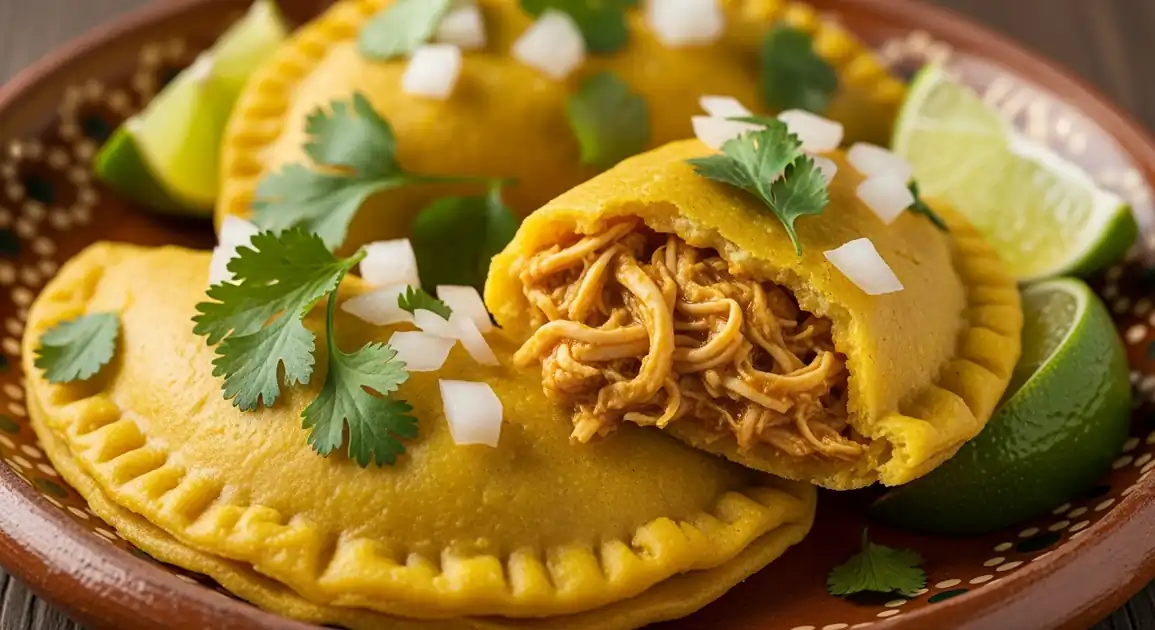Empanadas de Amarillo
Empanadas de Amarillo

Description
Oaxaca City and surrounding valleys are the heartland of Empanadas de Amarillo, where this dish reaches its most authentic and varied expressions. Here, skilled vendors maintain traditional techniques passed down through generations, using local ingredients like chilhuacle amarillo chiles and hierba santa. The dish represents the sophisticated indigenous culinary traditions that make Oaxaca Mexico's gastronomic capital.
Dietary Information
Serving information
Serving style
In markets, typically served on small plates or wrapped in paper with garnishes on the side. Street vendors serve them wrapped in paper, often with a plastic bag of salsa. Traditional clay plates in sit-down establishments.
Quick facts
Market vendors typically operate 7 AM - 4 PM, with peak freshness in morning hours. Street vendors often appear 8 AM - 2 PM. Restaurants serve throughout their business hours, typically 1 PM - 9 PM.
Safety Tips
What to Look For
-
Empanadas cooked fresh to order on a hot comal
Ensures the masa is fully cooked and the filling reaches a safe temperature. Fresh cooking also delivers the best texture contrast between crispy exterior and moist filling.
-
Mole amarillo kept at a proper hot temperature
The mole should be visibly hot and steaming, kept in a covered pot when not being served. This maintains food safety and flavor.
-
Clean preparation area with separate utensils for money and food
Reduces cross-contamination risk. Look for vendors who handle money and food separately or wash hands between tasks.
-
High turnover and local popularity
Vendors with steady business ensure fresh ingredients and prevent filling from sitting too long.
What to avoid
-
Pre-made empanadas sitting at room temperature
Empanadas that have been sitting out can harbor bacteria, especially in the meat filling. The masa also becomes tough and dry.
-
Lukewarm or room temperature mole amarillo
The filling should never be at the 'danger zone' temperature (40-140°F/4-60°C) where bacteria multiply rapidly.
-
Dirty preparation surfaces or visible cross-contamination
Watch out for vendors who handle raw ingredients, cooked food, and money without washing hands or changing gloves.
-
Mole amarillo with separated oil or discoloration
Signs the sauce has been reheated multiple times or held too long, affecting both safety and flavor.
Price information
Price range
Budget tips
- Market stalls in Mercado 20 de Noviembre offer empanadas for 15-25 MXN each.
- Street vendors in less touristy areas charge lower prices (15-20 MXN).
- Some vendors sell 'dos por' deals (two for a set price).
- Prices rise in tourist restaurants in the Centro Histórico (30-60 MXN).
- Thursday and Sunday tianguis (markets) often have competitive pricing.
Value indicators
- Made from scratch with hand-pressed masa.
- Generous portion of meat in rich, complex yellow mole.
- Proper ratio of filling to masa (should be substantial).
- Fresh, housemade mole rather than premade.
- Cooked to order on a hot comal.
- Complimentary garnishes and salsas.
Where to Find This Dish
Mercado 20 de Noviembre
The food hall section of this famous market houses several renowned empanada vendors.
Food hall section, Smoke hall (for meats), Central fountain
Morning, Early Afternoon
Mercado Benito Juárez
Traditional market with food stalls selling regional specialties.
Crafts section, Produce area, Food court
Morning, Midday
Mercado de la Merced
Less touristy market with authentic local food vendors.
Church of La Merced, Covered market area
Early Morning, Midday
Barrio de Jalatlaco
Traditional neighborhood with small family restaurants serving authentic Oaxacan cuisine.
Colorful colonial architecture, Templo de San Matías Jalatlaco
Lunch time, Early Evening
Vendor Tips
- Look for vendors who grind their own masa or get it fresh daily from a local molino (mill).
- Vendors with a dedicated pot of mole amarillo (not mixing many different dishes) often have better quality.
- Ask locals 'Dónde hay buenas empanadas?' for recommendations of favorite spots.
- The best vendors often sell out by early afternoon, so morning visits are recommended.
How to Order
Regional Variations
-
Empanadas de Amarillo con Chepil
(Empanadas de Amarillo con Chepil)
Incorporation of chepil, an aromatic wild herb native to Oaxaca, either in the filling or the masa.
-
Empanadas Fritas
(Empanadas Fritas)
Rather than cooked on a comal, some Oaxacan vendors deep-fry their empanadas for extra crispiness.
-
Empanadas de Amarillo con Tasajo
(Empanadas de Amarillo con Tasajo)
Filled with Oaxaca's famous air-dried beef (tasajo) instead of chicken or pork.
-
Empanadas de Mercado Tlacolula
(Empanadas de Mercado Tlacolula)
Specific style found at the Sunday market in Tlacolula, often larger with distinct folding techniques.
Cultural context
History
Empanadas de Amarillo represent the fusion of pre-Hispanic and Spanish culinary traditions. While the Spanish introduced the concept of empanadas, the indigenous Oaxacans adapted them using native corn masa instead of wheat flour and filling them with local ingredients. Mole amarillo itself is one of Oaxaca's seven traditional moles, developed over centuries and reflecting the region's biodiversity and culinary expertise. These empanadas are particularly associated with market culture and family celebrations in the Valley of Oaxaca.
Local significance
In Oaxaca, Empanadas de Amarillo represent the preservation of pre-Hispanic cooking techniques and ingredients, symbolizing the region's culinary heritage and resistance to culinary homogenization. They're an everyday food with deep cultural significance.
Eating customs
- In Oaxaca, they're typically eaten as a main dish rather than a snack.
- Often accompanied by tejate (traditional maize and cacao drink) or chilacayota (squash drink).
- Traditionally eaten by hand, never with utensils.
- Extra garnishes like chile de agua may be added according to preference.